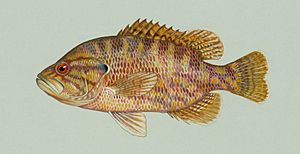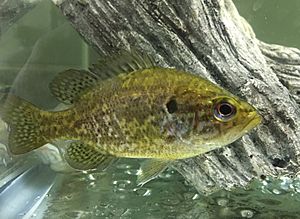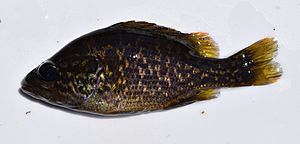Warmouth facts for kids
Quick facts for kids Warmouth |
|
|---|---|
 |
|
| Conservation status | |
| Scientific classification | |
| Synonyms | |
|
The warmouth (Lepomis gulosus) is a cool freshwater fish. It belongs to the sunfish family, called Centrarchidae. You can find warmouths all over the eastern United States. People sometimes call them by other names like molly, redeye, goggle-eye, or strawberry perch.
Contents
What Does a Warmouth Look Like?
Adult warmouths are usually dark with mottled brown colors. This means they have blotchy brown patterns. Their bellies are often golden. Male warmouths have a bright orange spot near their top fin.
They also have three to five reddish-brown lines that spread out from their eyes. Their gill flaps, which cover their gills, are often red. Warmouths have three spines on their anal fin and 10 spines on their dorsal fin (the one on their back). They even have tiny teeth on their tongue!
Warmouths usually grow to be about 4 to 10 inches long. Some can get even bigger, over 12 inches, and weigh up to 2.25 pounds.
How to Tell Warmouths Apart from Other Fish
Sometimes, people confuse warmouths with rock bass or green sunfish. These fish look similar because they all have big mouths and strong bodies.
However, you can spot the difference! Green sunfish usually have greenish-blue patterns on their gill flaps. They also have a black spot near their dorsal fin and yellowish-white edges on their fins. Rock bass have more spines on their anal fin (5-7) compared to the warmouth's three. Warmouths also tend to be a bit larger than these other two fish.
Where Do Warmouths Live?
Warmouths live in many places across the southern United States. They are found in the Mississippi River area, from the Gulf and Atlantic coasts. You can also find them north to the Chesapeake Bay and west into Texas, reaching the Rio Grande. They even live north in the Great Lakes area.
Warmouths are very tough and can live in many different places. They like ponds, lakes, rivers, and slow-moving streams. They can even survive in water with low oxygen levels. This is something many other sunfish cannot do. They have also been found in southern Canada for many years.
What Do Warmouths Eat?
Warmouths are sight feeders, meaning they hunt by seeing their prey. Their main diet includes insects, crayfish, and other small fish. Young warmouths mostly eat tiny crustaceans and insect larvae. Bigger warmouths prefer crayfish, freshwater shrimp, and other small fish.
Warmouths can live in water that is a bit polluted or has low oxygen. This is because they are very adaptable. They love to hide in areas with lots of plants, stumps, or brush piles. These spots help them ambush their prey and hide from bigger animals that might want to eat them.
Who Eats Warmouths?
Larger fish, snakes, turtles, alligators, and birds are some of the animals that hunt warmouths.
Warmouth Life Cycle and Reproduction
Warmouths start to reproduce when the water gets warm, usually around 21.1 degrees Celsius. This usually happens from May to July.
Male warmouths build nests on rocks or gravel, often near something like a log or plant in the water. Unlike many other sunfish, warmouths usually don't build their nests in big groups unless there's not much good nesting space.
When it's time to breed, the male warmouth's eyes turn red. After the female lays her eggs, the male fertilizes them. Then, he bravely guards the nest, eggs, and baby fish from anyone who comes near, even other female fish! Males often stay and protect the nest for up to five days until the babies hatch.
Young warmouths spend most of their time hiding under things at the bottom of the water. This helps them stay safe from predators. Most warmouths are ready to reproduce after about one year. However, their size is often a better sign of maturity than their age. Males usually grow faster than females. Warmouths can live for three to eight years, depending on where they live.
Warmouth Adaptability
Warmouths are very good at adapting to different conditions. They can live in many different river systems east of the Rocky Mountains. They often prefer slow-moving or even slightly polluted water.
Sometimes, warmouths can breed with other types of sunfish that live in the same areas. This doesn't seem to harm the warmouth species overall. Scientists keep an eye on warmouth populations. They believe there is no current threat to this hardy fish.
Warmouths and People
People sometimes fish for warmouths. The biggest warmouth ever caught with a fishing rod weighed 1.10 kilograms (about 2 pounds, 7 ounces). This record fish was caught in Holt, Florida in 1985.





